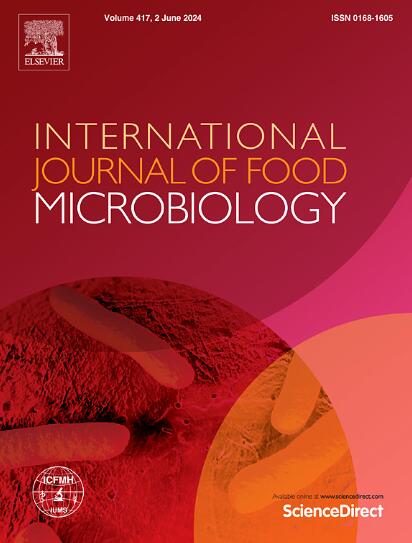Clonal distribution of livestock-associated methicillin-resistant Staphylococcus aureus in pig farms of Korea: Emergence of a novel variant staphylococcal chromosome cassette mec
IF 5
1区 农林科学
Q1 FOOD SCIENCE & TECHNOLOGY
International journal of food microbiology
Pub Date : 2025-07-09
DOI:10.1016/j.ijfoodmicro.2025.111341
引用次数: 0
Abstract
Livestock-associated methicillin-resistant Staphylococcus aureus (LA-MRSA) is a considerable concern in pig farming due to its antimicrobial resistance and zoonotic potential. However, data on the genetic characteristics of LA-MRSA in Korean pig farms remain limited. This study investigated the prevalence, antimicrobial resistance profiles, and genetic diversity of LA-MRSA in Korean pig farms using whole-genome sequencing (WGS). Overall, 1515 samples were collected from 74 pig farms nationwide, yielding 96 MRSA isolates from 17 farms. All isolates exhibited multidrug resistance, with CC398 (ST398, spa type t571, SCCmec type V) as the dominant lineage. Notably, 35 isolates carried an SCCmec type III + V combination, which has not been reported in Korea. WGS analysis of 28 representative isolates identified six clonal clusters and seven singletons, with potential inter-farm transmission observed in four clusters spanning different provinces. Complete genome analysis revealed a novel SCCmec variant, found in a distinct cluster of six isolates from two separate farms purchasing pigs from the same breeding company. These findings highlight the ongoing clonal expansion of CC398, emergence of novel SCCmec elements, and potential role of breeding networks in LA-MRSA dissemination. Enhanced surveillance, biosecurity measures, and antimicrobial stewardship are necessary to mitigate the spread of LA-MRSA within pig farms and its potential impact on public health.
韩国猪场中家畜相关耐甲氧西林金黄色葡萄球菌的克隆分布:一种新型变异葡萄球菌染色体盒型mec的出现
家畜相关的耐甲氧西林金黄色葡萄球菌(LA-MRSA)由于其抗菌素耐药性和人畜共患的潜力,在养猪业中是一个相当令人担忧的问题。然而,关于韩国养猪场的LA-MRSA遗传特征的数据仍然有限。本研究利用全基因组测序(WGS)技术调查了韩国养猪场LA-MRSA的流行情况、耐药性特征和遗传多样性。总体而言,从全国74个猪场收集了1515份样本,从17个猪场分离出96株MRSA。所有分离株均表现出多药耐药,以CC398 (ST398, spa型t571, SCCmec V型)为优势菌株。值得注意的是,35株分离株携带SCCmec III + V型组合,这在韩国尚未报道。对28个代表性分离株的WGS分析鉴定出6个克隆群和7个单株,在不同省份的4个群中观察到潜在的农场间传播。全基因组分析揭示了一种新的SCCmec变体,在从同一育种公司购买猪的两个不同农场的6个分离株中发现。这些发现强调了CC398的持续克隆扩增,新的SCCmec元件的出现,以及育种网络在LA-MRSA传播中的潜在作用。加强监测、生物安全措施和抗菌剂管理对于减轻LA-MRSA在猪场内的传播及其对公共卫生的潜在影响是必要的。
本文章由计算机程序翻译,如有差异,请以英文原文为准。
求助全文
约1分钟内获得全文
求助全文
来源期刊
CiteScore
10.40
自引率
5.60%
发文量
322
审稿时长
65 days
期刊介绍:
The International Journal of Food Microbiology publishes papers dealing with all aspects of food microbiology. Articles must present information that is novel, has high impact and interest, and is of high scientific quality. They should provide scientific or technological advancement in the specific field of interest of the journal and enhance its strong international reputation. Preliminary or confirmatory results as well as contributions not strictly related to food microbiology will not be considered for publication.

 求助内容:
求助内容: 应助结果提醒方式:
应助结果提醒方式:


